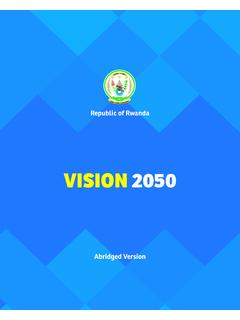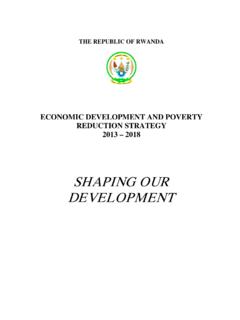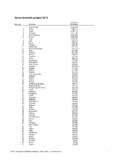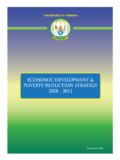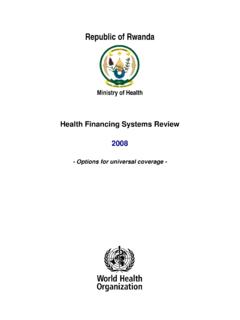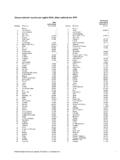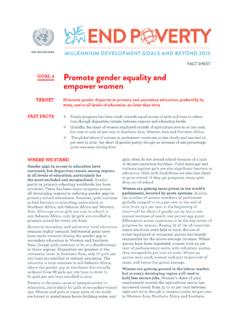Transcription of REPUBLIC OF RWANDA - MINECOFIN
1 REPUBLIC OF RWANDA FINAL REPORT RWANDA FINANCIAL SECTOR STRATEGY 2013-2018 FINANCIAL SECTOR DEVELOPMENT SECRETARIAT, MINECOFIN i ACKNOWLEDGEMENTS This Financial Sector Strategy was commissioned by MINECOFIN and funded by Access Finance RWANDA (AFR). The assignment was undertaken by an independent consultant Mr. Stephen Hitimana and supported by staff at MINECOFIN and AFR. The consultant also received inputs and comments from various financial sector players in RWANDA . The policy interventions of this strategy were mainly drawn from Financial Sector Development Program II and Strategy for Creating a Financial Services Centre in RWANDA as per the Terms of Reference. The consultant wished to thank the authors of both reports for a recommendable work done. The report has been also enriched by information, analysis, discussion and reviews by various individuals and institutions.
2 We are sincerely grateful for their invaluable contributions ii TABLE OF CONTENTS ACRONYMS .. iii FOREWORD .. iv EXECUTIVE SUMMARY .. v CHAPTER 1: INTRODUCTION .. 1 CHAPTER 2: OVERVIEW OF THE FINANCIAL SECTOR .. 4 FINANCIAL SECTOR MILESTONES .. 4 FINANCIAL SECTOR STRUCTURE .. 5 SECTOR ACHIEVEMENTS .. 7 SECTOR EMERGING CHALLENGES FOR EDPRS 2 .. 15 CHAPTER 3: STRATEGIC FRAMEWORK .. 25 CONCEPTUAL APPROACH FOR THE FINANCIAL SECTOR DEVELOPMENT .. 25 FINANCIAL SECTOR PRIORITIES .. 30 FINANCIAL SECTOR PRIORITIES FOR DISTRICTS .. 65 CHAPTER 4: IMPLEMENTATION OF THE STRATEGY .. 66 INSTITUTIONAL FRAMEWORK .. 66 RISKS AND MITIGATION .. 69 CHAPTER 5: MONITORING AND EVALUATION .. 70 CHAPTER 6: FINANCIAL SECTOR COSTING .. 72 BIBLIOGRAPHY/REFERENCES .. 75 ANNEXE 1: Financial Sector Monitoring Matrix .. 77 ANNEXE 2 : Policy matrix .. 80 ANNEXE 3: Priority policy actions .. 83 iii ACRONYMS AFF - Access to Finance Forums AFR - Access to Finance RWANDA ASSAR - Association des Assureurs de RWANDA ATM - Automated Teller Machine BNR - National Bank of RWANDA BPR - Banque Populaire de RWANDA CMA - Capital Markets Authority CRB - Credit Reference Bureau CSD - Central Securities Depository EAC - East African Community FSDP I - First Financial Sector Development Program FSDP II - Second Financial Sector Development Program FSDS - Financial Sector Development Secretariat GDP - Gross Domestic Product IMF - International Monetary Fund IT - Information Technology MINECOFIN - Ministry of Finance and Economic Planning MIS - Management Information System MFI - Microfinance Institution M&E - Monitoring and Evaluation MMT - Mobile Money Transfer MMO - Mobile Money Operator OTC - Over-the-counter POS - Point of Sale RAMA - La Rwandaise d Assurance Maladie RBA - RWANDA Bankers Association RCA - RWANDA Cooperative Agency RDB.
3 RWANDA Development Board RIPPS - RWANDA Integrated Payment Processing System RSE - RWANDA Stock Exchange RSSB - RWANDA Social Security Board RTGS - Real Time Gross Settlement RWF - Rwandan Francs SACCO - Savings and Credit Cooperative SWG - Sector Working Group VSLA - Village Savings and Loan Associations VUP - Vision Umurenge Program 7 YGP - Seven Year Government Plan iv FOREWORD The RWANDA Financial Sector Strategy is a long-term development strategy that governs the entire financial sector of RWANDA . It is obvious that the strategy will definitely help in the achievement of the financial sector objectives as set out in Vision 2020, EDPRS II, 7 year Government Program, FSDPII and Strategy for RWANDA becoming an international service centre. The Strategy focuses on financial inclusiveness driven by Access to Finance as the Government rediscovers the benefits of savings. The particular attention has been to reach out to the remaining underserved Rwandans through fast expansion of private credit which has to be accompanied by saving as a key enabler to finance productive activities.
4 The priorities of the Strategy to be pursued for the next five years are savings and investments, access to finance, financial inclusion, modern payment system, skills development and creating an international service centre for RWANDA . Ultimately, once these priorities are achieved, there is no doubt that the strategy will have contributed to fostering economic growth and poverty reduction. The strategy is cognizance of the on-going regional and international initiatives with regard to financial sector development as well as anticipated future challenges. There is no doubt that the successful implementation and outcome of the strategy will offer significant benefits to RWANDA and will only be possible with the support and constant follow-up from all stakeholders through Sector Working Group Monitoring Mechanism lead by the FSDS and Co-chair DFID. This should be a continuation of the process that led to the development of Strategy that builds on the entire consultation process for the elaboration of FDSP II and IFSC that involved a wide- spectrum of the financial sector stakeholders.
5 Sincere thanks to all of you who contributed and supported the formulation of the Strategy and FSDP II. Financial Sector Secretariat Ministry of Finance and Economic Planning v EXECUTIVE SUMMARY The overarching vision of the sector is to develop a stable and sound financial sector that is sufficiently deep and broad, capable of efficiently mobilizing and allocating resources to address the development needs of the economy and reduce poverty. Through this sector vision, the financial sector plays an important role to the general economic growth of the country. Its contribution is well documented in the past five years. It should be recognized that when financial services reach out to the population broadly and efficiently, they accelerate economic growth, efficient allocation of resources and improved wealth distribution. This is what RWANDA needs to drive the aspiration of the country s Vision 2020. To achieve a more sustainable economic growth and development, we need a deepened, broadened and developed financial system, well regulated and competitive, an inclusive and financially literate population to accelerate growth.
6 A recent review of RWANDA s financial sector highlighted that although the sector has made remarkable achievement, it still faces major challenges that need addressing to enable the financial sector to contribute meaningfully to the overall performance of the country s economy. The key challenges identified include; RWANDA s low savings rates as a result of low savings culture, limited access to banking products and services in the rural areas and low incomes that translates into low savings. Another challenge facing RWANDA is the country s inability to mobilize long term stable financing given that RWANDA s capital market is small and underdeveloped to enable public and private sector access long term financing. Furthermore, 28% of the Rwandan population have no access to finance and are financially excluded exacerbated by MFI/banks/SACCOs inability to reach out to the rural areas due to the fact that most of MFIs being concentrated in urban and major cities.
7 There is also a need to create a supporting infrastructure through the expansion of electronic payments systems for credit and debit cards, Automated Teller Machines, and point of sale terminals and harmonizing and integration of supporting pillars for the payment and settlement systems with the EACs. There is also a lack of qualified graduates and experienced financial services professionals to meet the needs of the recent development of the financial sector. Another challenge is creating RWANDA an international service centre which will require tax harmonization with international and regional countries, entering double taxation agreements, and competitive skills specialists. This five year strategy has been developed to address the major challenges in the Rwandan Financial sector covering the period of 2013-2018 which will enable the country financial sector play a significant role to transform and contribute meaningfully to the development objectives of the country.
8 Vi The strategy will focus on the following most critical priorities Mobilizing savings and investment Access to Finance Financial Inclusion Modernized Payment Systems Skill Development for the Financial Sector International Financial Service Centre Mobilizing savings for investment The BNR will continue to strengthen its monetary policy to ensure liquidity management through the support of interbank markets both money and foreign exchange market and the implementation of the reserve money program. Measures to further enhance repo operations will be pursued by selecting one point on the short-end yield curve corresponding to the Key Repo Rate (KRR) and allowing interest rates on other maturities to be fully market determined. The capital markets legal foundation will be virtually complete when the remaining laws and regulations are put in place within the next year. Creating a government bond market and yield curve is the most important element of capital market development at this juncture.
9 Therefore Government will establish a regular bond issuance program. The three elements of bond market development are introduction regular government bond issues to build a yield curve, broadening the investor base through the growth of contractual savings such as pensions, and promoting private sector bond issuance. To this end, large infrastructure projects or private public partnerships will be encouraged to include a domestic financing component. Another key policy intervention for savings mobilization is the establishment of RWANDA Funds of Funds. The government will complementary the fund by setting a seed capital for the fund and resource mobilization campaign targeting the private sector and development partners will need to be launched to complement Government s seed capital Insurance industry performance has improved since the adoption of new legislation in 2009. Further refinement of the regulatory regime will be introduced to foster its development, including completion of the separation of life and non-life businesses, and revisions to capital, solvency and investment rules.
10 RWANDA -specific mortality (life) tables will be developed to foster development of life insurance and annuity products. RWANDA Social Security Board (RSSB), the largest Rwandan financial institution, will be provided with enhanced autonomy and accountability to enable it to effectively manage the investment portfolio. As capital markets develop, the RSSB will become a major purchaser of bonds and equities, as these long term assets are well suited to its long term liabilities, and more liquid than the current real-estate dominated portfolio. vii Enactment of the Pension Law will establish the basis for private pension plans. This will meet the social objective of facilitating retirement savings, as well as playing an important role in mobilizing long-term savings and contributing to capital market development. BNR will put an appropriate licensing and supervision regime in place to protect consumers and ensure pension funds are able to meet their financial promises.
